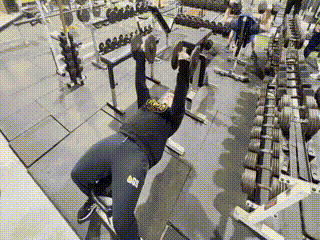Ultimate Tricep Dumbbell Workout for Athletes
Serving a stiff arm, shooting a ball, throwing a shot put, or locking out a jerk. All these actions require the same thing - STRONG AF triceps. The triceps muscles are a group of muscles that serve countless roles for athletes.
Not only are triceps important for sports performance, they are important for the ego too. You can spend hundreds of hours training your biceps as you try to grow your arms. The real secret to huge arms…is huge triceps!
The triceps typically account for 55% of upper arm muscle mass, while the biceps only amount to 30%. So let’s look at some of the best dumbbell triceps exercises that you can throw into the upper body days of your strength training program.
TABLE OF CONTENTS
What Are the Tricep Muscles?
The Triceps Brachii, more commonly known as the triceps, is a key muscle located on the back of the upper arm bone, opposite of the biceps. The muscle plays a crucial role in arm movements, such as extending the elbow joint and providing stability for the shoulder. What makes the triceps unique is its structure, consisting of three different heads: the long head, lateral head, and medial head.

Long Head
The long head of the triceps is unique from the other two heads, in that it originates on the scapula (shoulder), rather than on the arm. As the longest of the three heads, the long head makes up the overall mass and shape of the triceps.
The long head extends down the back of the arm, joining the other two heads to form one common muscle tendon that inserts into the forearm. The long head is involved in movements that require shoulder extension, making it essential for actions like reaching overhead. Targeting the long head when exercising is important for well-rounded tricep development, with an emphasis on strengthening movements involving shoulder and elbow extension.

Lateral Head
The lateral head of the triceps plays a crucial role in upper arm function and aesthetics. Located on the outer portion of the arm, the lateral head largely contributes to the overall width and definition of the triceps muscle. Originating on the back of the humerus (arm), the lateral head is actively involved in movements that require elbow extension. Emphasizing this head not only improves the appearance of the arm but also contributes to functional strength. Incorporating lateral head targeted exercises in your workout routine is key to achieving a defined and strong tricep muscle.

Medial Head
Located on the back of the arm, the medial head of the triceps adds thickness and mass to the tricep muscle, as it inserts into the shared common tendon. The medial head participates in movements that require elbow joint extension, providing stability and strength during pushing and lifting activities. Balancing the overall appearance and strength of the triceps muscle by including exercises that specifically target the medial head is essential for preventing muscle imbalances and optimizing upper body strength.
Dumbbell Triceps Exercises to Use
In the pursuit of well-defined, strong arms, the triceps play a crucial role. Dumbbells, with their versatility and accessibility, are an excellent tool for targeting and isolating the triceps.
Miracle Gro
A Garage Strength native exercise, similar to an overhead tricep extension or a skull crusher, the Miracle Gro is a great exercise to blast all three heads of the triceps while working the shoulders, lats, and core. The movement forms a connection from the triceps, through the deltoids, and to the thoracic spine. Perform the Miracle Gro to improve stability in the shoulder and that overhead lock-out position.

How to Perform the Miracle Gro:
- Lay perpendicular to a flat bench, with your upper back and the bottom of your neck resting on the bench.
- Hold a dumbbell directly over your face with open palms and the arms extended. Slowly move the dumbbell past your head, and as your arms pass your ears, flex your elbows to get a deeper stretch in the triceps.
- Lengthen the triceps as deep as possible, and then extend the dumbbell back into the starting position.
Neutral Grip Dumbbell Press
This would be an alternative to incline or close grip bench press.
The neutral grip of the press not only decreases shoulder stress, but it allows for the engagement of different muscle fibers, emphasizing the inner chest and triceps. The grip provides better stability during the pressing motion, allowing for controlled, balanced movement.

How to Perform the Neutral Grip Dumbbell Press:
- Sit on the edge of the bench with your dumbbells. Hold the dumbbells with a neutral grip, palms facing each other.
- With the dumbbells resting on your thighs, lie back, and extend the arms to press the dumbbells over the shoulders.
- Begin to slowly lower the dumbbells by bending the elbows, and keeping the elbows tucked. Allow the elbows to bend to form a 90-degree angle or slightly less, just until the dumbbells come close to or touch the shoulder/chest.
- Return to the starting position, pressing dumbbells up and extending your arms.
Close Grip Dumbbell Press

How to Perform the Close-grip Dumbbell Press:
- Sit on a flat bench with a dumbbell in each hand. Hold the dumbbells with a neutral grip, palms facing each other.
- With the dumbbells resting on your thighs, lie back, extending the arms to press the dumbbells overhead. The dumbbells should be above the chest.
- Hold the dumbbells with a close grip, bringing them together closer than shoulder width. The dumbbells should be touching.
- Lower the dumbbells slowly, allowing your elbows to form a 90-degree or slightly lower until the dumbbells lightly touch the chest.
- Return to the overhead lockout position, placing an emphasis in extending through your triceps
Dumbbell Floor Press

How to Perform the Dumbbell Floor Press:
- Sit upright on the floor, with a dumbbell in each hand.
- Lie on your back onto the floor, with knees bent and feet flat.
- Extend the dumbbells straight up towards the ceiling, locking out the elbows overhead. The dumbbells should be above the chest/shoulders.
- Position the dumbbells at a 45-degree angle, and slowly lower the dumbbells to the sides of your chest, initiating the movement with your elbows.
- Lower the dumbbells until the upper arms touch the floor, keeping the elbows tucked.
- Return to the starting position by fully extending the arms.
Dumbbell Tate Press

How to Perform the Dumbbell Tate Press:
- Sit on a flat bench, with dumbbells in each hand.
- Lie down on the bench, holding dumbbells with an overhand grip with palms facing forward. Fully extend the arms, holding the dumbbells above your chest.
- Begin to lower the inner portions of the dumbbells toward the chest, with the dumbbells touching each other on the way down.
- Allow the elbows to flare out, and initiate the movement by bending the elbows.
- Once the dumbbells touch your chest, reverse the motion by extending the elbows, and locking the arms out overhead. The inner portion of the dumbbells should remain touching until you return to the starting position.
Dumbbell Telle Extensions

How to Perform Telle Extensions:
- Lay flat on a bench with your arms extended at the top of a pressing position. The dumbbells should be a neutral grip.
- Slowly lower the dumbbells toward your head as if you were doing a skull crusher. You will then go past your head into a full extension as if you were doing a miracle gro.
- As you reach full extension, bend the elbows to fully lengthen the triceps. At this point you have completed the eccentric portion of the lift.
- Keeping your elbows bent, use your lats to pull the dumbbells to the base of your chest - maintaining the neutral grip press position once you arrive.
- Finish the movement by pressing the dumbbells upwards to the starting position.
Dumbbell Overhead Triceps Extensions

How to Perform the Dumbbell Overhead Tricep Extension:
- Sit on a bench or stand with your back straight, keeping your core engaged. Hold one dumbbell with both hands, using your palms to support the underside of the dumbbell head.
- Lift the dumbbell overhead, extending the arms to be fully straight.
- Keeping your arms close to your ears and elbows staying in the same position, slowly bend the elbows to fully lengthen the tricep muscle and lower the dumbbell behind your head.
- Using the elbows to contract the triceps, extend your arms back to the overhead position.
Skull Crushers
Because of the range of motion skull crushers provide, the movement also engages other elbow flexors, increasing overall upper body strength. Skull crushers can be easily modified—whether it be laying on a flat bench or an incline bench to engage various muscle groups.

How to Perform Dumbbell Skull Crushers:
- With a dumbbell in each hand, lie on a flat or incline bench.
- Extend the arms fully in a lockout position, holding the dumbbell above your chest. Your palms should be facing each other, in a neutral grip.
- Keeping your arms close to your ears and your elbows in the same position, slowly lower the dumbbell to the sides of your head by bending your elbows to stretch the triceps, keeping your elbows pointed at the ceiling.
- Once the triceps are fully stretched and engaged, extend your elbows, and return to the overhead position.
Dishonorable Mention: Tricep Kickbacks

Sample Tricep Dumbbell Workout

Using Dumbbells vs a Barbell
More Range of Motion
Isolating the Upper Arm

Improving Imbalances

Bottom Line
Blog Topics

Yo, It's Dane
Welcome to the Garage Strength Blog, where it is my goal to provide you with the experience and knowledge I've gained in the strength and conditioning world over many years of learning from both successes and failures. I train elite-level athletes in a multitude of sports from the high school to professional levels, already producing 5 Olympics and 30+ National Champions. If you want to be the next champion I train, check out my strength programs below!
Start Training With Me

Join for free educational videos EVERY WEEK on strength coaching and athletic performance

